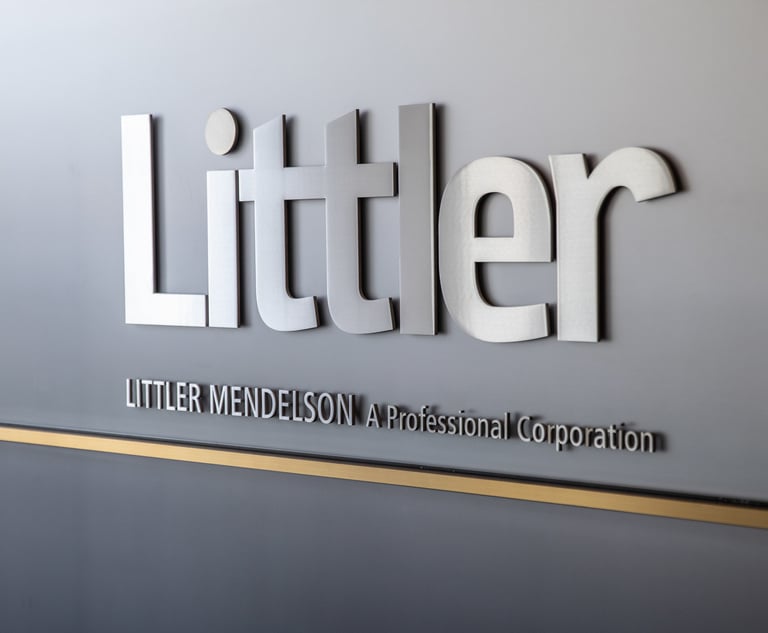High-Rate Work Went to the Largest Law Firms Last Year, but Discounts Are Now Rising
The largest 50 firms by attorney head count commanded 77% of M&A work, according to a new report.
July 14, 2020 at 11:25 AM
4 minute read
 Working businessman
Working businessman
Large law firms continued to dominate high-rate work last year, but as clients reexamine their relationships during the pandemic in 2020, law firms have been heavily discounting, according to a new report based on law firm invoices.
For its 2020 Enterprise Legal Management Trends Report, CounselLink said it analyzed charges billed by outside counsel derived from nearly $35 billion in legal spending and almost 7 million invoices.
According to the report, the country's largest 50 law firms, which each have more than 750 attorneys, earned 62% of invoice amounts billed last year in three combined categories: mergers and acquisitions; corporate, general and tax; and finance, loans and investments.
"[The largest firms] really have a hold on those markets," said Kris Satkunas, director of strategic consulting at LexisNexis CounselLink and the report's author. "It's almost a chicken-and-the-egg thing: the larger the firm, the higher its rate. But a higher rate drives up the firms' average income, meaning the firm can grow even larger."
Specifically, among its sample of invoices, the largest 50 law firms commanded 77% of M&A work; 63% of finance, loans and investments work; and 58% of corporate, general and tax work in 2019.
According to the report, partners at the largest 50 firms, who billed an average of $575 per hour, billed at rates 51% higher than law firms with 501-750 lawyers, where partners billed an average of $380 per hour. Partners at law firms with 201-500 lawyers, who billed an average of $201-500 per hour, billed at rates 29% higher than law firms with 101-200 lawyers, where partners billed an average of $295 per hour.
"I don't think people realize how strong the correlation is between the size of the firm and the rates," Satkunas said. Firms slightly smaller than the "largest firms" category, ones with head counts of 501-750 lawyers, have an opportunity, she added, as clients look for high-quality legal work at a lower cost.
The report found that average partner rates among all law firms were $765 in M&A, $643 in corporate, general and tax; and $615 in finance, loans, and investments. Regulatory and compliance, trademark, patent and commercial were also relatively higher billing practice areas in 2019, with partners' average billing rates exceeding $500 per hour.
Partner rates grew in major cities from 2018 to 2019, with partner rates in New York increasing 6.9%; rates in Boston increasing 5.9%; rates in San Francisco increasing 5.7%; rates in Washington, D.C., increasing 5.2%; and rates in Chicago increasing 4.7%. Miami, Minneapolis and Phoenix all had partner rate growth below 3% in 2019.
The report also studied the consolidation of outside counsel, finding that for 58% of companies in its data pool, 10 or fewer law firms accounted for more than 80% of external legal bills. This number is similar to the consolidation figures in previous studies. Manufacturing companies; professional, scientific, and technical services companies; and retail trade companies had high degrees of outside counsel consolidation, while the insurance industry had a lower degree of consolidation.
As clients reexamine relationships with their law firms this year during a recession, Satkunas said the industry may see more discounted bills. And the CounselLink data is bearing that out. The report found a trend of increased discounting in the past few months of 2020, with more than 16% of bills discounted in May, a threshold normally crossed only at the end of the year.
However, Satkunas added she was hopeful that more firms will work with clients to adopt alternative fee arrangements, which have grown in popularity in recent years. In 2019, 12.1% of matters were billed with an alternative fee arrangement, up from 9.2% two years ago, and she said there is now an opportunity for firms and clients to be more creative.
"Every time I see a bump [in the share of matters billed under a form of alternative billing], I'm hopeful that we're finally moving away from talking about alternative fee arrangements and starting to embrace them," she said. "We're seeing that uptick in invoices being discounted, and I hope those two things go hand in hand: that more creative pricing also comes into play."
This content has been archived. It is available through our partners, LexisNexis® and Bloomberg Law.
To view this content, please continue to their sites.
Not a Lexis Subscriber?
Subscribe Now
Not a Bloomberg Law Subscriber?
Subscribe Now
NOT FOR REPRINT
© 2025 ALM Global, LLC, All Rights Reserved. Request academic re-use from www.copyright.com. All other uses, submit a request to [email protected]. For more information visit Asset & Logo Licensing.
You Might Like
View All

Three Akin Sports Lawyers Jump to Employment Firm Littler Mendelson

Brownstein Adds Former Interior Secretary, Offering 'Strategic Counsel' During New Trump Term
2 minute read
Trending Stories
- 1Critical Mass With Law.com’s Amanda Bronstad: LA Judge Orders Edison to Preserve Wildfire Evidence, Is Kline & Specter Fight With Thomas Bosworth Finally Over?
- 2What Businesses Need to Know About Anticipated FTC Leadership Changes
- 3Federal Court Considers Blurry Lines Between Artist's Consultant and Business Manager
- 4US Judge Cannon Blocks DOJ From Releasing Final Report in Trump Documents Probe
- 5White & Case KOs Claims Against Voltage Inc. in Solar Companies' Trade Dispute
Who Got The Work
J. Brugh Lower of Gibbons has entered an appearance for industrial equipment supplier Devco Corporation in a pending trademark infringement lawsuit. The suit, accusing the defendant of selling knock-off Graco products, was filed Dec. 18 in New Jersey District Court by Rivkin Radler on behalf of Graco Inc. and Graco Minnesota. The case, assigned to U.S. District Judge Zahid N. Quraishi, is 3:24-cv-11294, Graco Inc. et al v. Devco Corporation.
Who Got The Work
Rebecca Maller-Stein and Kent A. Yalowitz of Arnold & Porter Kaye Scholer have entered their appearances for Hanaco Venture Capital and its executives, Lior Prosor and David Frankel, in a pending securities lawsuit. The action, filed on Dec. 24 in New York Southern District Court by Zell, Aron & Co. on behalf of Goldeneye Advisors, accuses the defendants of negligently and fraudulently managing the plaintiff's $1 million investment. The case, assigned to U.S. District Judge Vernon S. Broderick, is 1:24-cv-09918, Goldeneye Advisors, LLC v. Hanaco Venture Capital, Ltd. et al.
Who Got The Work
Attorneys from A&O Shearman has stepped in as defense counsel for Toronto-Dominion Bank and other defendants in a pending securities class action. The suit, filed Dec. 11 in New York Southern District Court by Bleichmar Fonti & Auld, accuses the defendants of concealing the bank's 'pervasive' deficiencies in regards to its compliance with the Bank Secrecy Act and the quality of its anti-money laundering controls. The case, assigned to U.S. District Judge Arun Subramanian, is 1:24-cv-09445, Gonzalez v. The Toronto-Dominion Bank et al.
Who Got The Work
Crown Castle International, a Pennsylvania company providing shared communications infrastructure, has turned to Luke D. Wolf of Gordon Rees Scully Mansukhani to fend off a pending breach-of-contract lawsuit. The court action, filed Nov. 25 in Michigan Eastern District Court by Hooper Hathaway PC on behalf of The Town Residences LLC, accuses Crown Castle of failing to transfer approximately $30,000 in utility payments from T-Mobile in breach of a roof-top lease and assignment agreement. The case, assigned to U.S. District Judge Susan K. Declercq, is 2:24-cv-13131, The Town Residences LLC v. T-Mobile US, Inc. et al.
Who Got The Work
Wilfred P. Coronato and Daniel M. Schwartz of McCarter & English have stepped in as defense counsel to Electrolux Home Products Inc. in a pending product liability lawsuit. The court action, filed Nov. 26 in New York Eastern District Court by Poulos Lopiccolo PC and Nagel Rice LLP on behalf of David Stern, alleges that the defendant's refrigerators’ drawers and shelving repeatedly break and fall apart within months after purchase. The case, assigned to U.S. District Judge Joan M. Azrack, is 2:24-cv-08204, Stern v. Electrolux Home Products, Inc.
Featured Firms
Law Offices of Gary Martin Hays & Associates, P.C.
(470) 294-1674
Law Offices of Mark E. Salomone
(857) 444-6468
Smith & Hassler
(713) 739-1250









